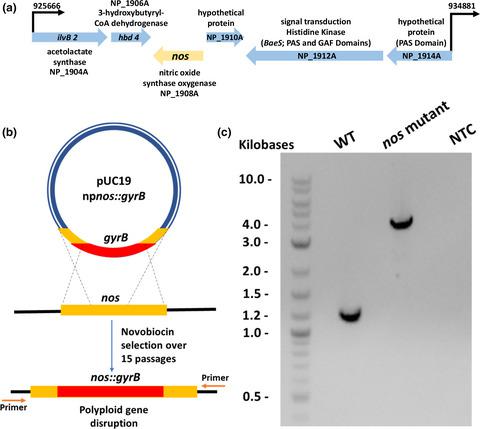当前位置:
X-MOL 学术
›
Microbiologyopen
›
论文详情
Our official English website, www.x-mol.net, welcomes your
feedback! (Note: you will need to create a separate account there.)
Bacterial‐like nitric oxide synthase in the haloalkaliphilic archaeon Natronomonas pharaonis
MicrobiologyOpen ( IF 3.9 ) Pub Date : 2020-10-14 , DOI: 10.1002/mbo3.1124 Silvia S Orsini 1 , Kimberly L James 1 , Destiny J Reyes 1 , Ricardo L Couto-Rodriguez 1 , Miriam K Gulko 2 , Angela Witte 3 , Ronan K Carroll 4 , Kelly C Rice 1
MicrobiologyOpen ( IF 3.9 ) Pub Date : 2020-10-14 , DOI: 10.1002/mbo3.1124 Silvia S Orsini 1 , Kimberly L James 1 , Destiny J Reyes 1 , Ricardo L Couto-Rodriguez 1 , Miriam K Gulko 2 , Angela Witte 3 , Ronan K Carroll 4 , Kelly C Rice 1
Affiliation

|
Bacterial nitric oxide (NO) synthases (bNOS) play diverse and important roles in microbial physiology, stress resistance, and virulence. Although bacterial and mammalian NOS enzymes have been well‐characterized, comparatively little is known about the prevalence and function of NOS enzymes in Archaea. Analysis of archaeal genomes revealed that highly conserved bNOS homologs were restricted to members of the Halobacteria. Of these, Natronomonas pharaonis NOS (npNOS) was chosen for further characterization. NO production was confirmed in heterologously expressed His‐tagged npNOS by coupling nitrite production from N‐hydroxy‐L‐arginine in an H2O2‐supported reaction. Additionally, the nos gene was successfully targeted and disrupted to create a Nmn. pharaonis nos mutant by adapting an established Natrialba magadii transformation protocol. Genome re‐sequencing of this mutant revealed an additional frameshift in a putative cation–acetate symporter gene, which could contribute to altered acetate metabolism in the nos mutant. Inactivation of Nmn. pharaonis nos was also associated with several phenotypes congruent with bacterial nos mutants (altered growth, increased oxygen consumption, increased pigment, increased UV susceptibility), suggesting that NOS function may be conserved between bacteria and archaea. These studies are the first to describe genetic inactivation and characterization of a Nmn. pharaonis gene and provides enhanced tools for probing its physiology.
中文翻译:

嗜盐碱古菌 Natronomonas pharaonis 中的类细菌一氧化氮合酶
细菌一氧化氮 (NO) 合酶 (bNOS) 在微生物生理学、应激抵抗和毒力中发挥着多种重要作用。尽管细菌和哺乳动物的一氧化氮合酶(NOS)酶已被充分表征,但人们对古细菌中一氧化氮合酶(NOS)酶的普遍性和功能知之甚少。对古细菌基因组的分析表明,高度保守的 bNOS 同源物仅限于盐细菌的成员。其中,选择Natronomonas pharaonis NOS (npNOS) 进行进一步表征。通过在 H 2 O 2支持的反应中耦合 N-羟基-L-精氨酸产生的亚硝酸盐,在异源表达的带有 His 标签的 npNOS 中证实了 NO 的产生。此外, nos基因被成功靶向并破坏,产生了Nmn。 pharaonis nos突变体通过采用已建立的Natriba Magadii转化方案来实现。该突变体的基因组重测序揭示了假定的阳离子-乙酸盐同向转运蛋白基因中的额外移码,这可能导致nos突变体中乙酸盐代谢的改变。 Nmn 失活。 pharaonis nos还与一些与细菌nos突变体一致的表型相关(生长改变、耗氧量增加、色素增加、紫外线敏感性增加),这表明 NOS 功能在细菌和古细菌之间可能是保守的。这些研究首次描述了Nmn 的基因失活和特征。 pharaonis基因并提供增强的工具来探测其生理学。
更新日期:2020-11-12
中文翻译:

嗜盐碱古菌 Natronomonas pharaonis 中的类细菌一氧化氮合酶
细菌一氧化氮 (NO) 合酶 (bNOS) 在微生物生理学、应激抵抗和毒力中发挥着多种重要作用。尽管细菌和哺乳动物的一氧化氮合酶(NOS)酶已被充分表征,但人们对古细菌中一氧化氮合酶(NOS)酶的普遍性和功能知之甚少。对古细菌基因组的分析表明,高度保守的 bNOS 同源物仅限于盐细菌的成员。其中,选择Natronomonas pharaonis NOS (npNOS) 进行进一步表征。通过在 H 2 O 2支持的反应中耦合 N-羟基-L-精氨酸产生的亚硝酸盐,在异源表达的带有 His 标签的 npNOS 中证实了 NO 的产生。此外, nos基因被成功靶向并破坏,产生了Nmn。 pharaonis nos突变体通过采用已建立的Natriba Magadii转化方案来实现。该突变体的基因组重测序揭示了假定的阳离子-乙酸盐同向转运蛋白基因中的额外移码,这可能导致nos突变体中乙酸盐代谢的改变。 Nmn 失活。 pharaonis nos还与一些与细菌nos突变体一致的表型相关(生长改变、耗氧量增加、色素增加、紫外线敏感性增加),这表明 NOS 功能在细菌和古细菌之间可能是保守的。这些研究首次描述了Nmn 的基因失活和特征。 pharaonis基因并提供增强的工具来探测其生理学。











































 京公网安备 11010802027423号
京公网安备 11010802027423号